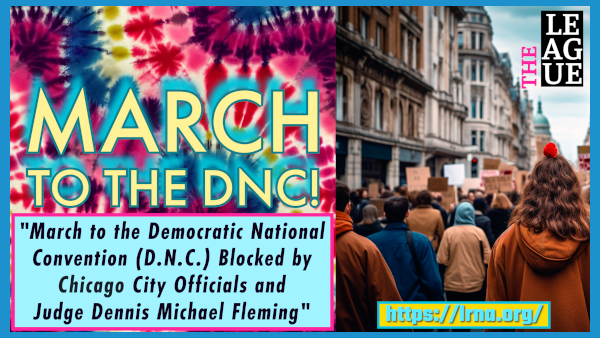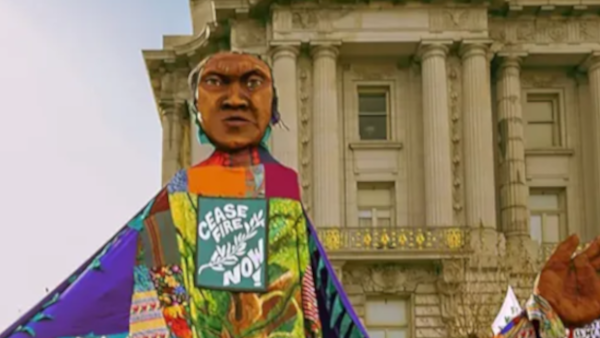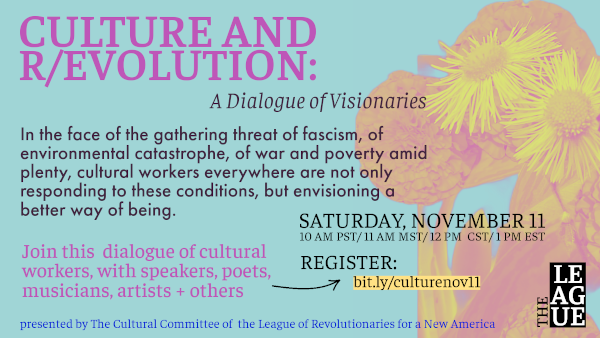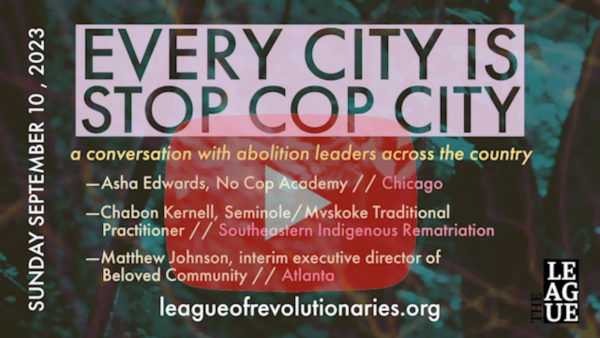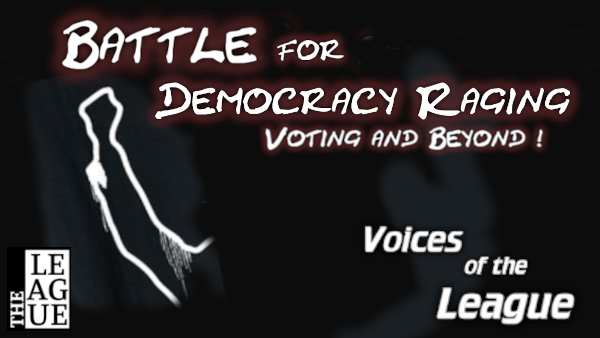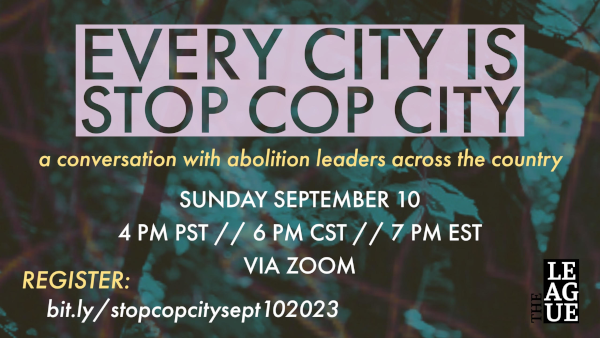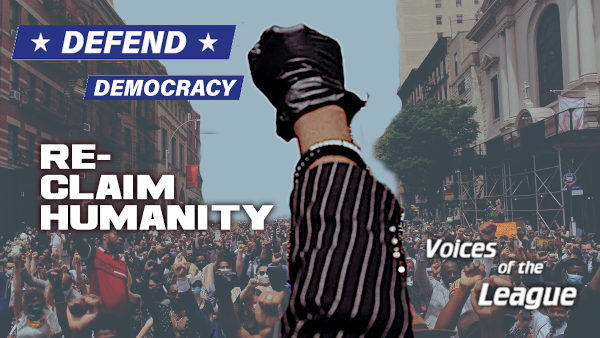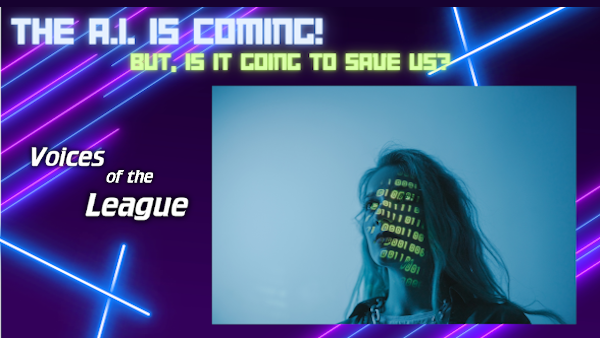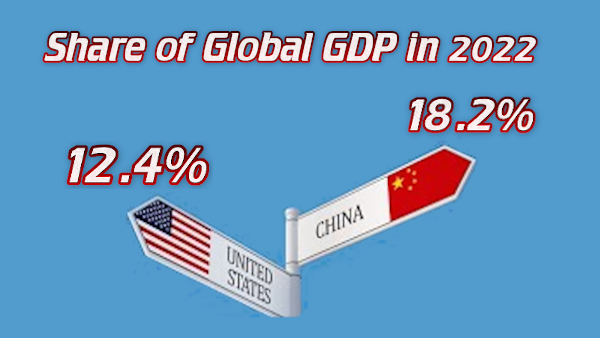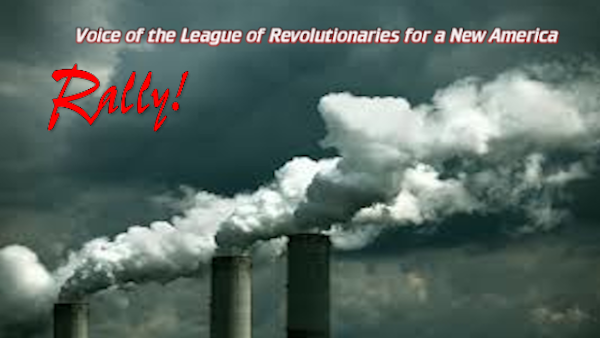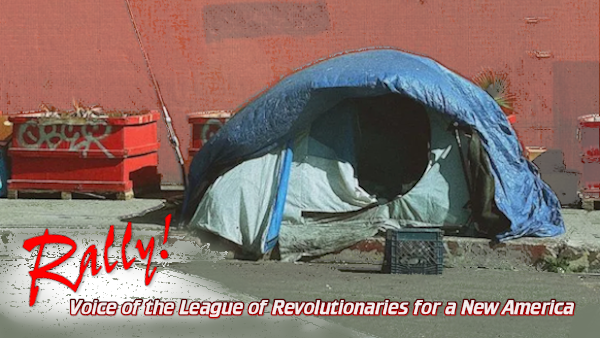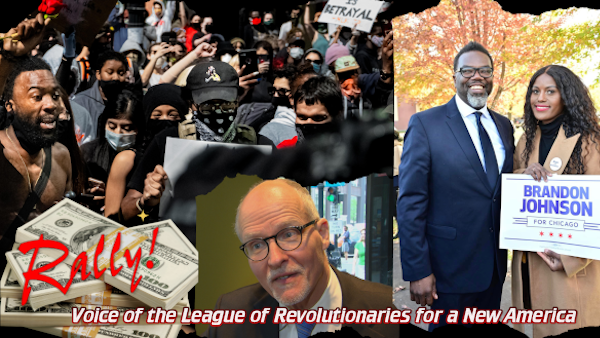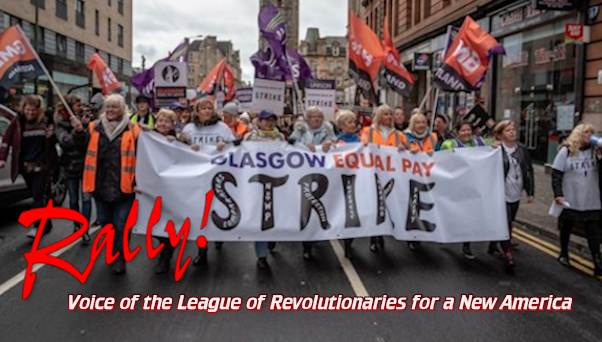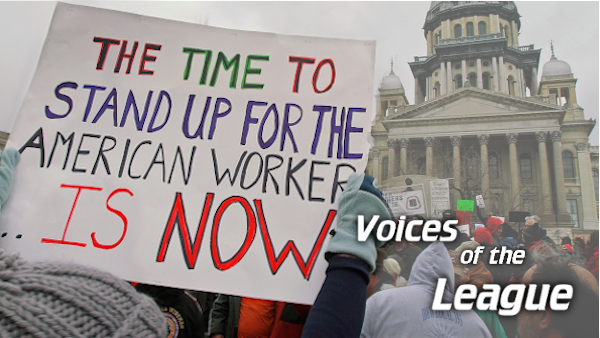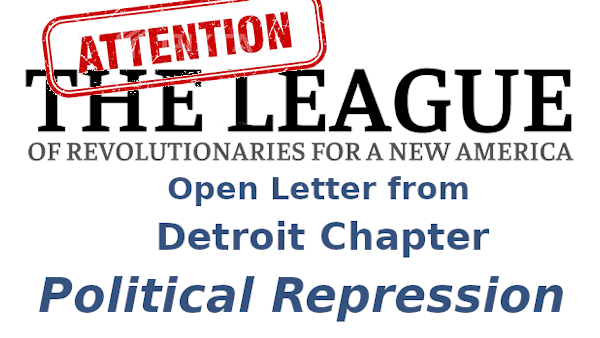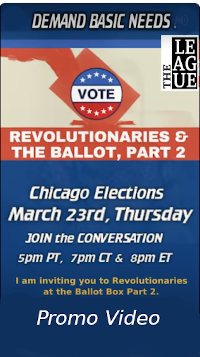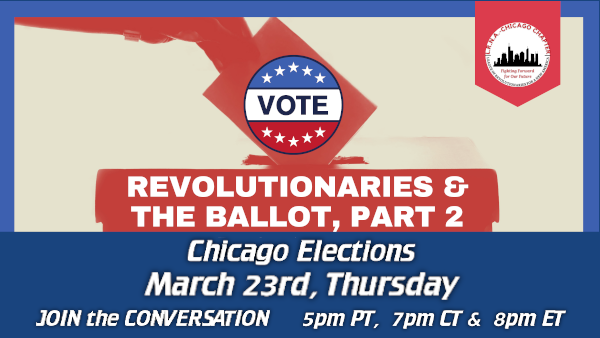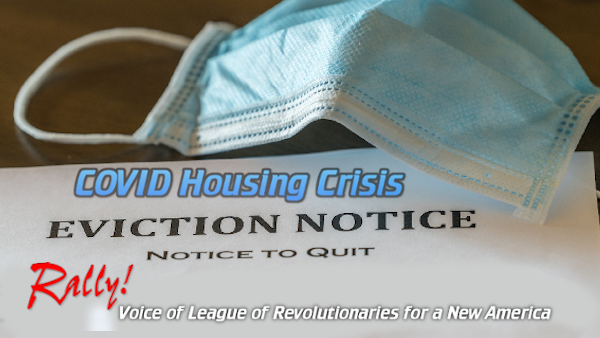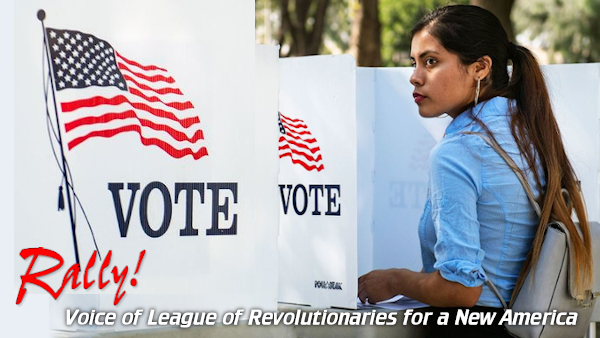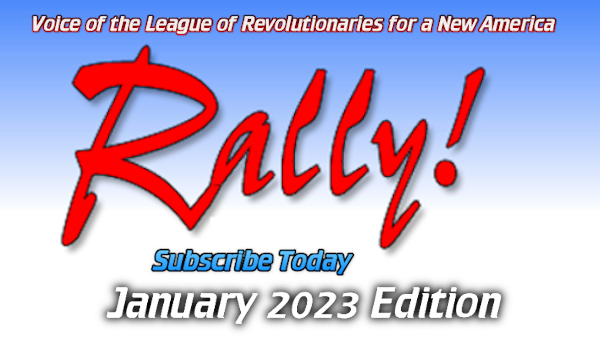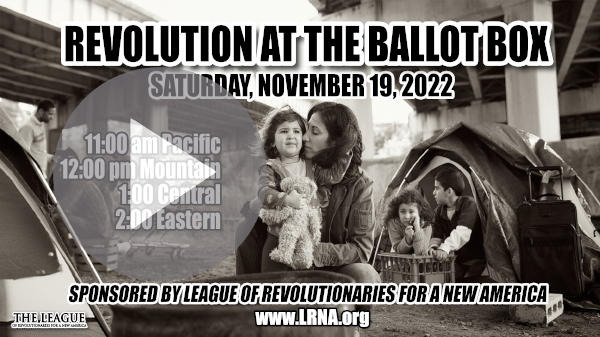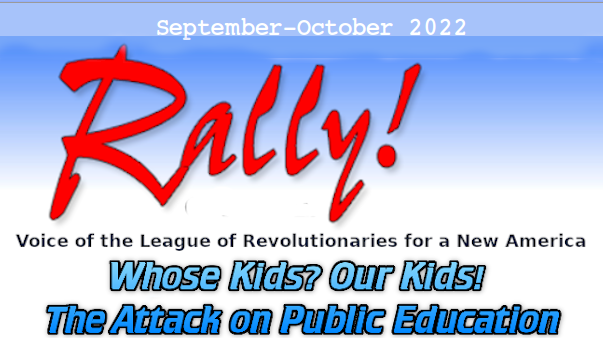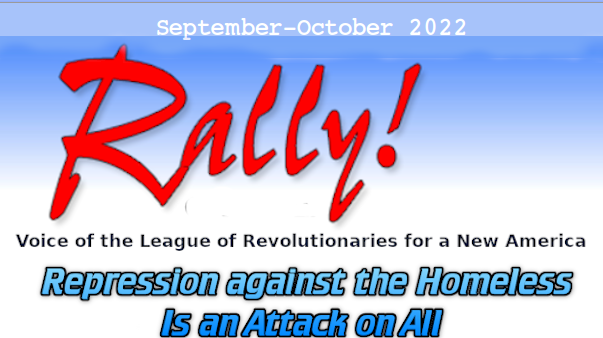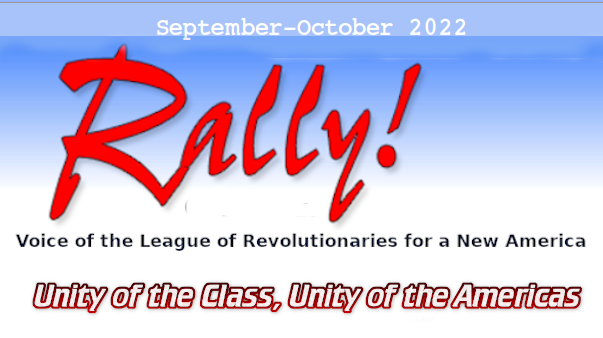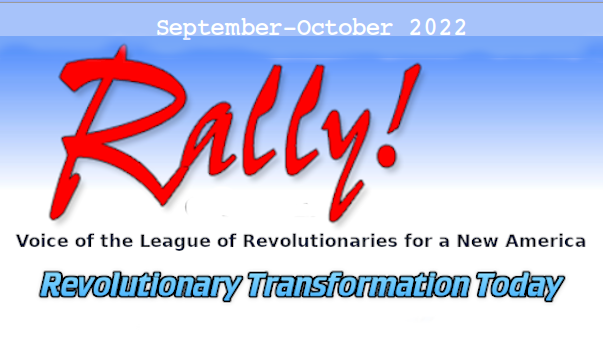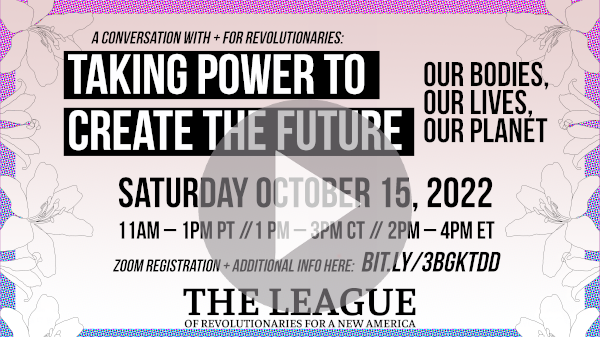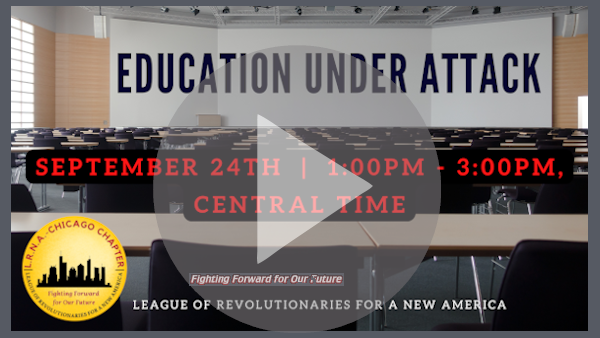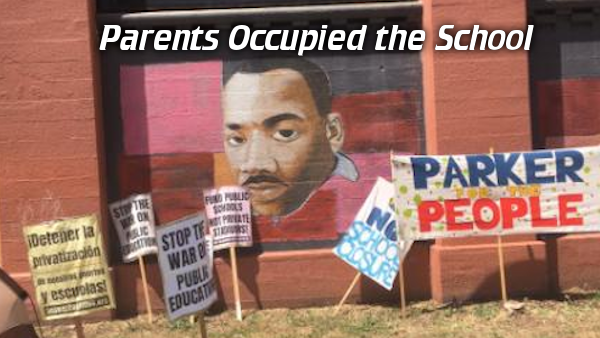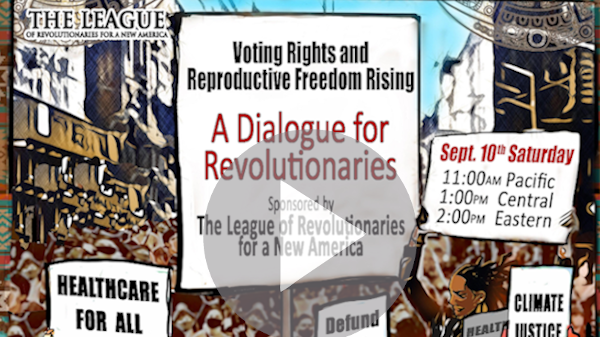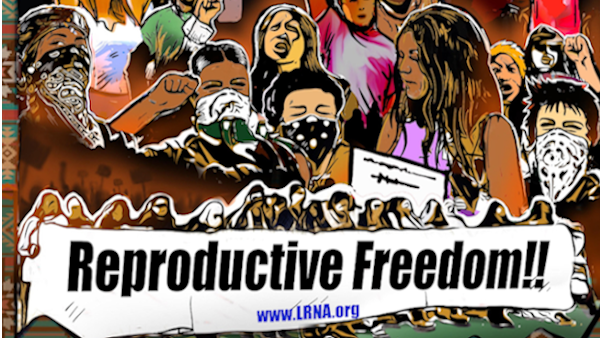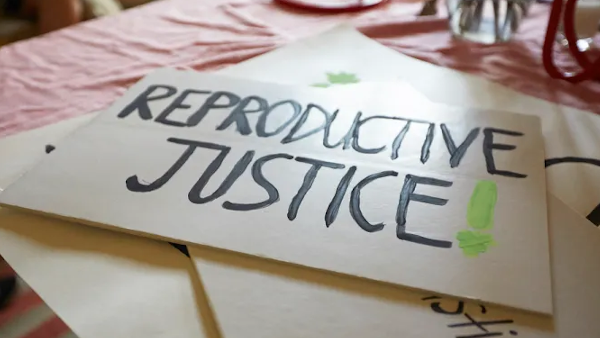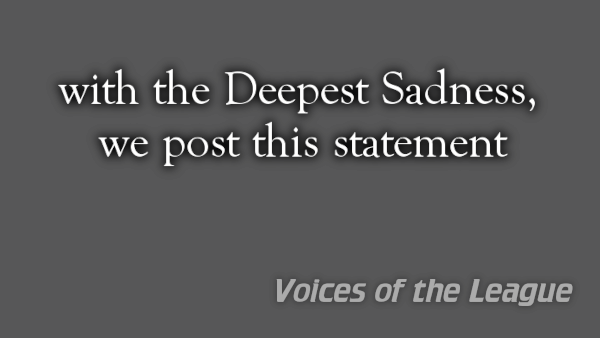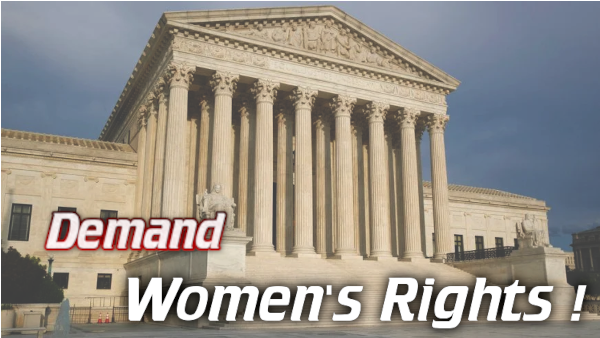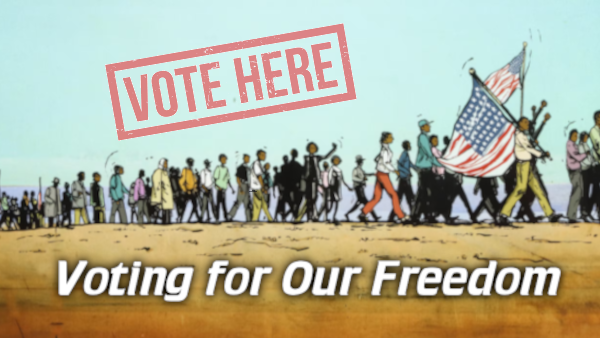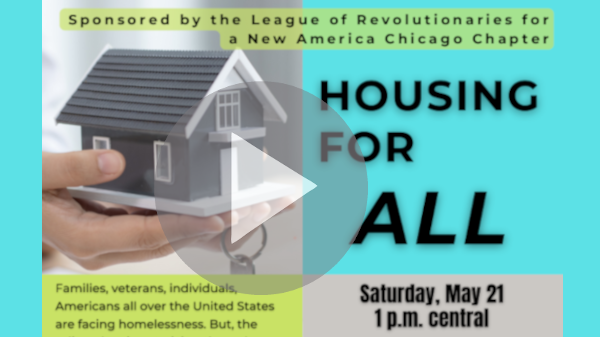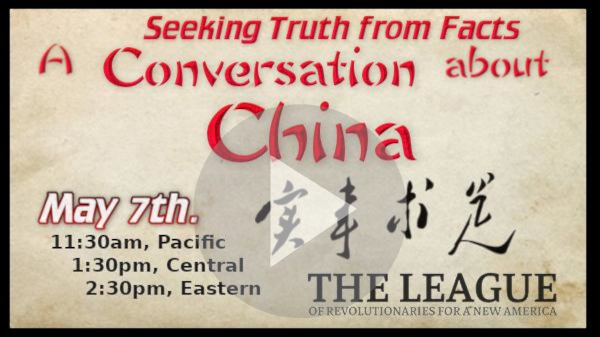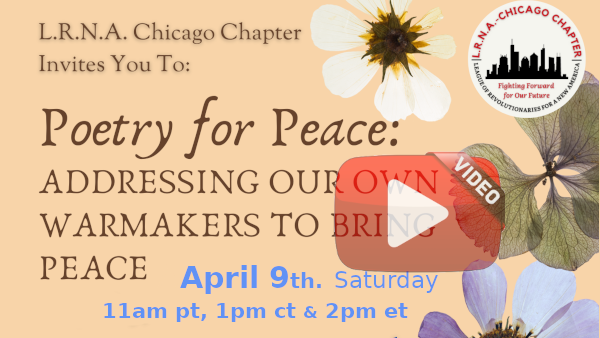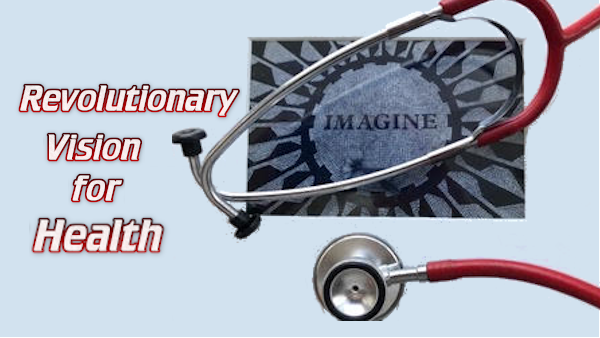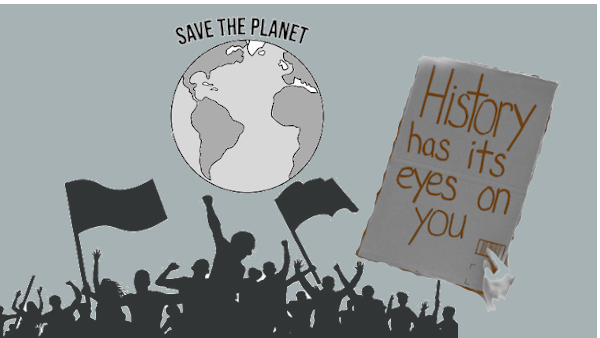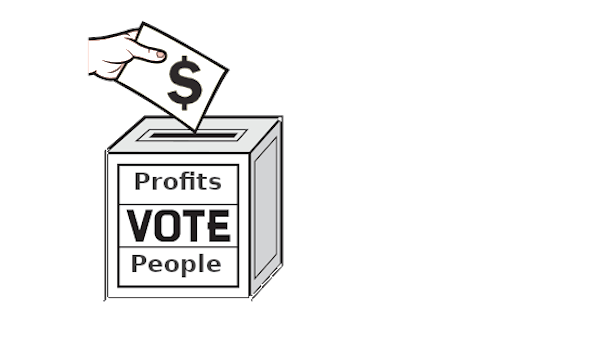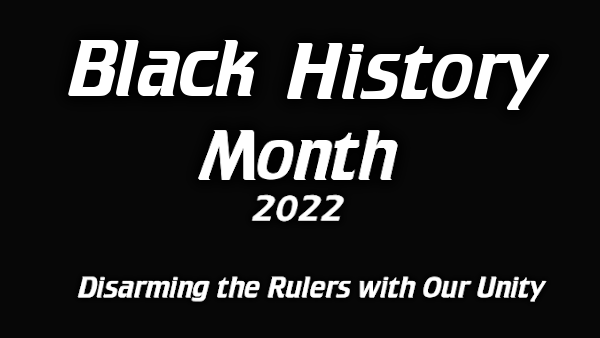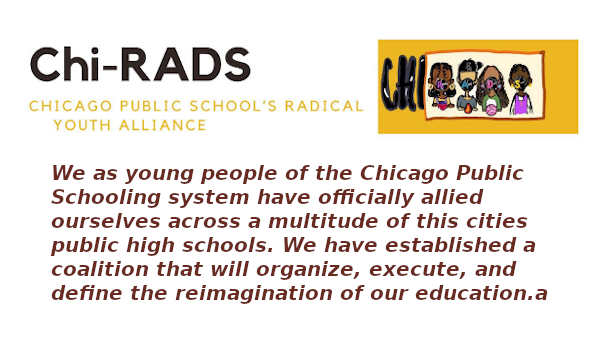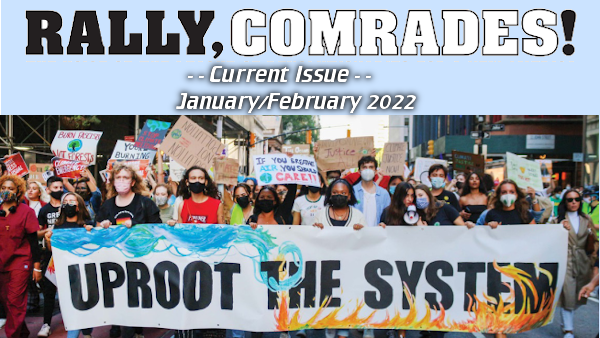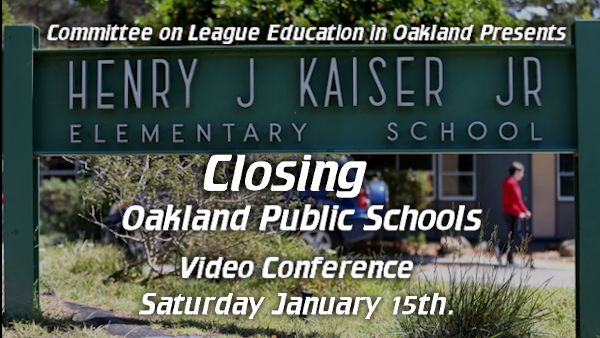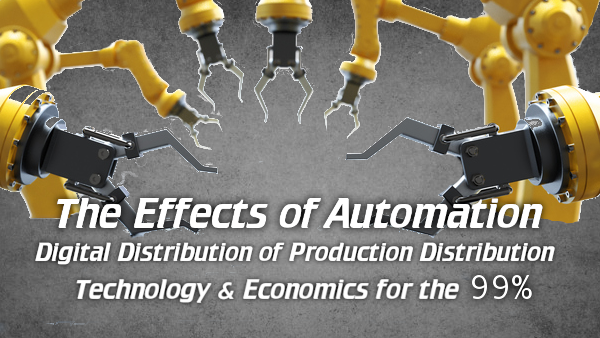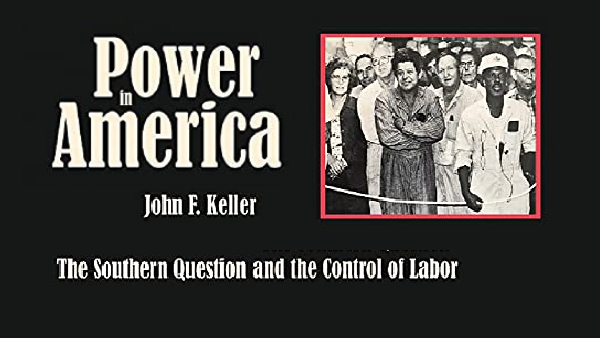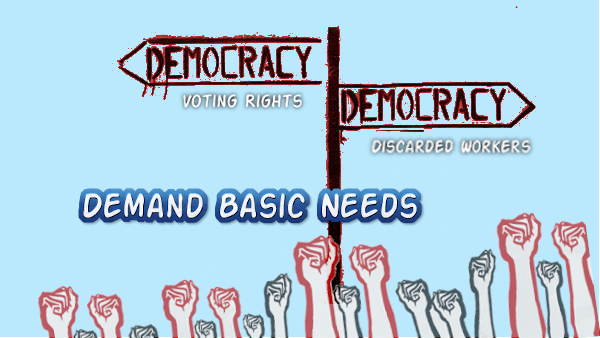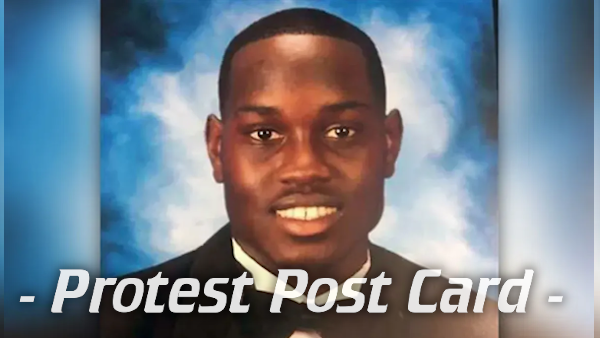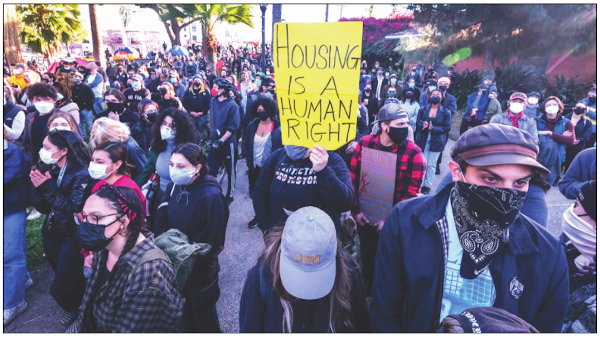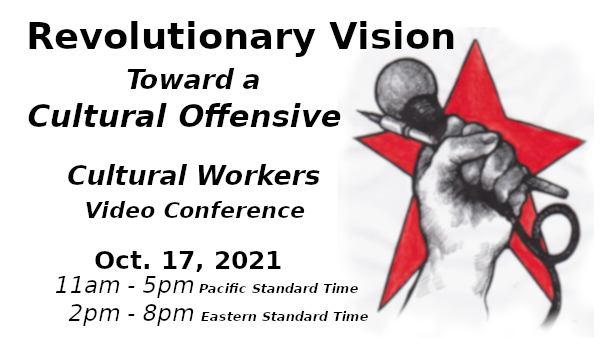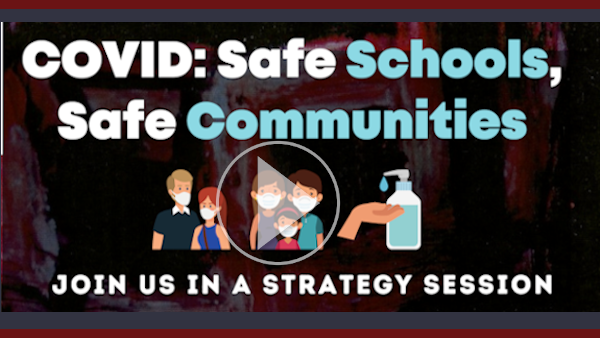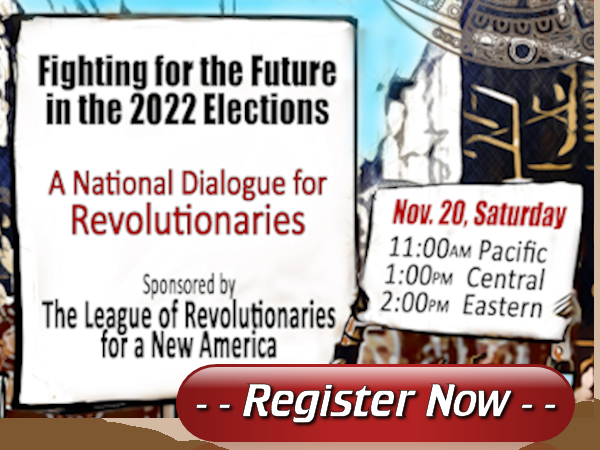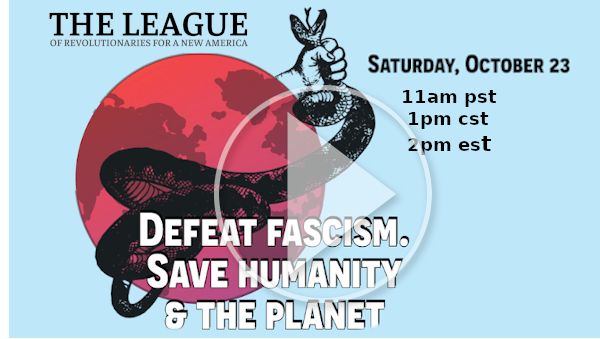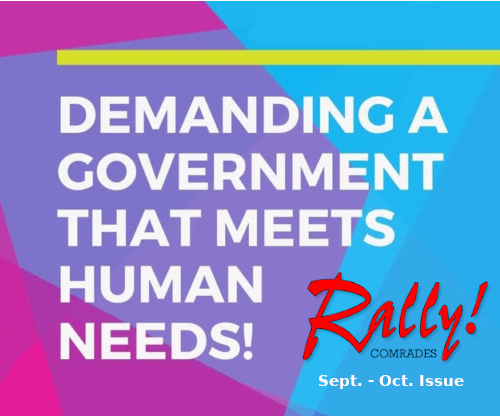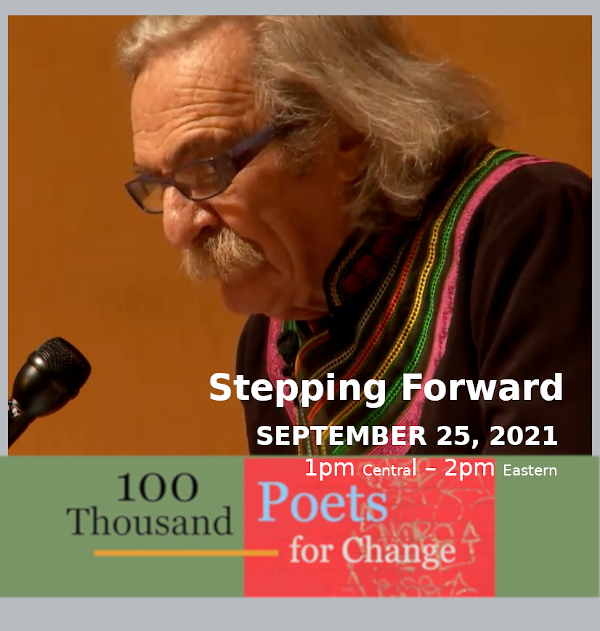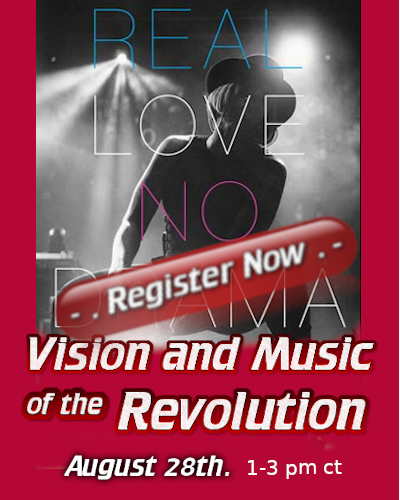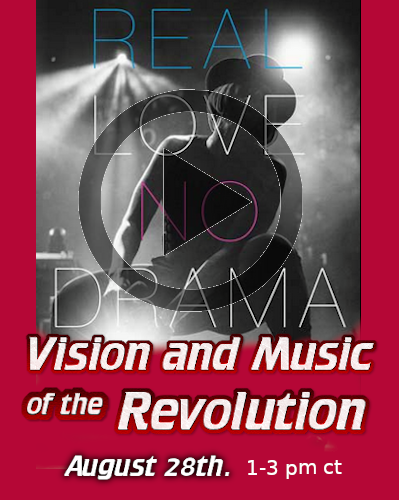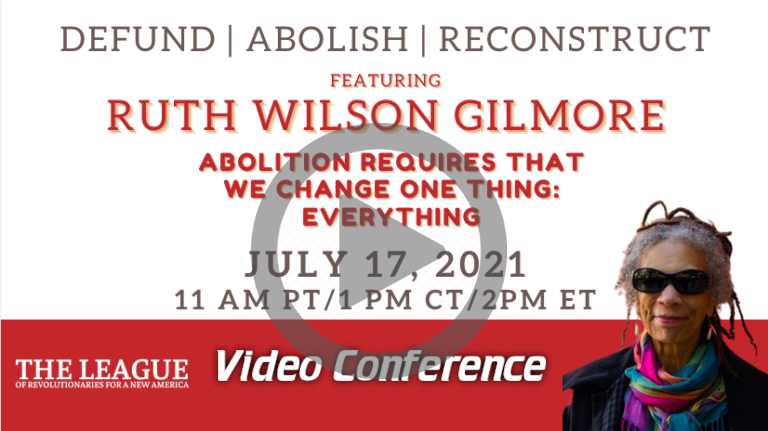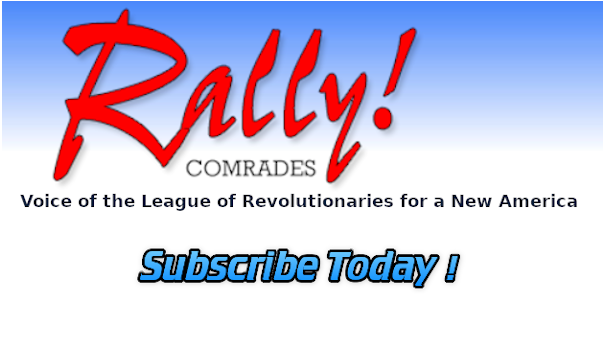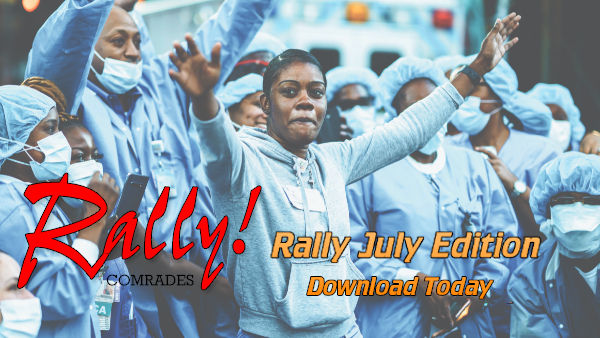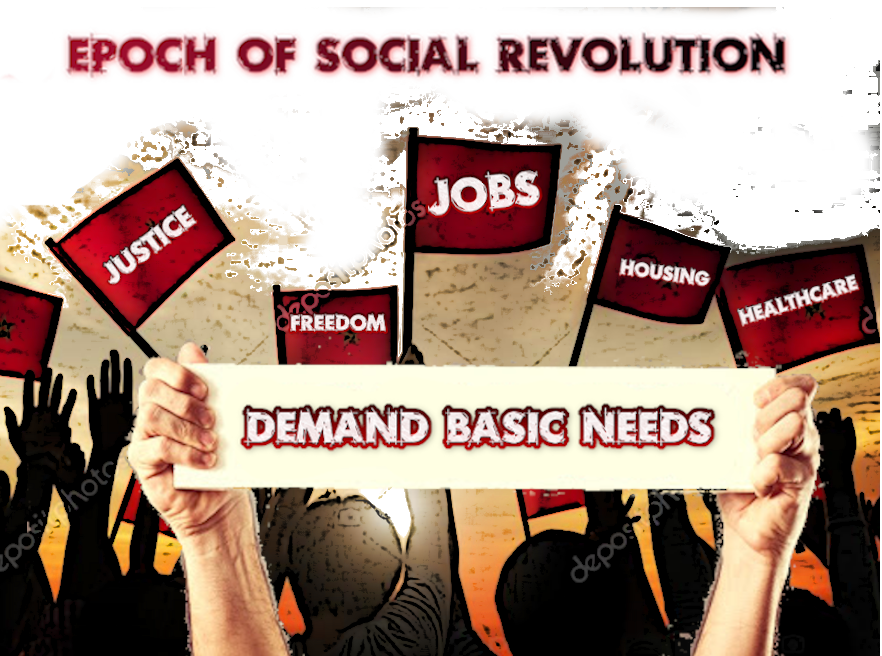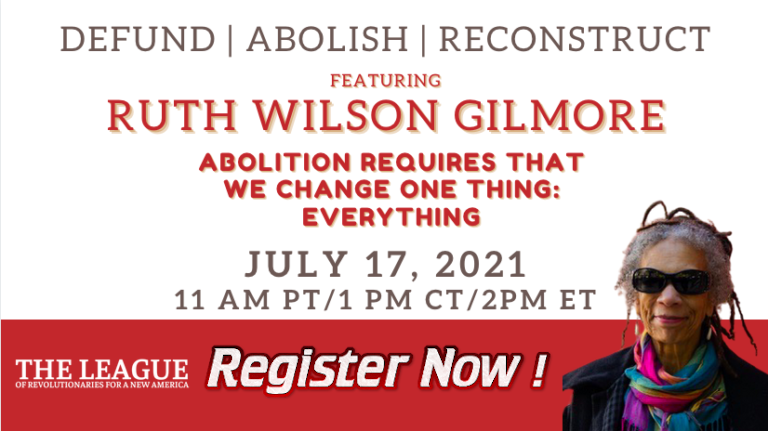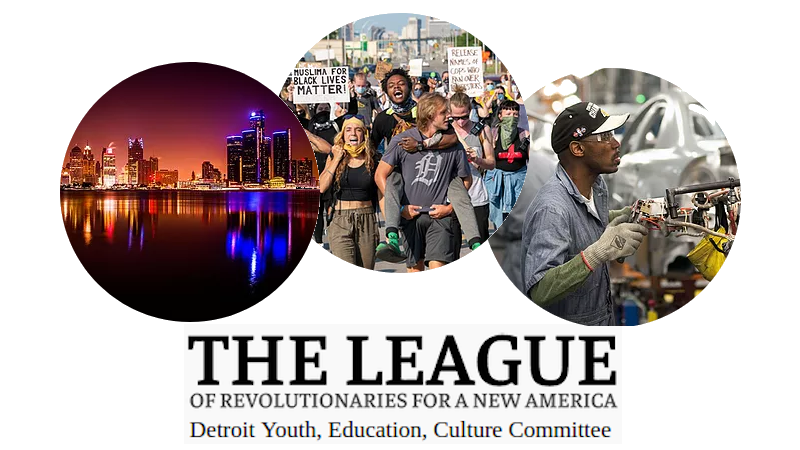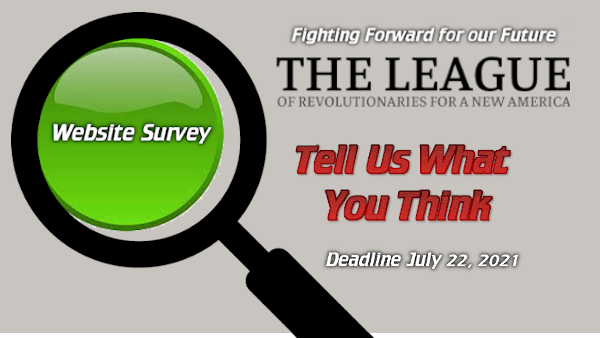Political Resolution
League of Revolutionaries for a New America
11th. Convention 2022
1. Introduction
We are living in revolutionary times. We witness unheard of advances in science and technology, including the invention of vaccines in record time and the ability to communicate instantly across the globe. We see the growing political awareness and engagement in the huge protests in response to the police murder of George Floyd and so many others, the broadening rejection of white supremacy, the growing climate and water protector movements, and the largest voter turnout in 120 years. At the same time, poverty and homelessness, global pandemics, climate catastrophe and ecological devastation, the dictatorship of corporations, police violence, voter suppression, an attempted coup, and the growth of hate groups, are all accentuated by the development of a 21st century fascism.
The global ruling class that controls the tools and technologies of society has pushed humanity and Nature to the brink. For over a decade now, and in the face of a pandemic, the people of the world, including the United States, have been in rising rebellion against the capitalist class. As a result, the ruling class turns to fascism to use anger and fear to divert and confuse the rising working-class movements. Fascism is the open terroristic dictatorship of corporate power, carried out by the State apparatus. It requires a mass base recruited from those who are or could embrace the fascist alternative. The growth of this mass base is apparent today.
The fight against fascism is a fight for basic human needs for all, for democracy, for the control of government, and for the future of humanity and the planet. By taking the offensive to defeat fascism, the working class can pass over to the offensive against capitalism and private property, the seedbed of fascism.
Economic exploitation and class society have inflicted harm on Nature to the point where the Earth and its climate can no longer sustain life for many species, including the human one.
Murderous pandemics and famine, hurricanes and drought, disastrous heat and fires: All are intensifying inequalities in society. All are wreaking destruction and contamination, compelling massive migration, and igniting wars. Danger and promise face humanity and the earth.
For hundreds of thousands of years humans lived in harmony with Nature. The development of class society transformed property used in common into private property owned by a dominant class that exploited labor and land; resulting in the ever-escalating destruction of natural resources and land and impoverishing the majority of human society.
As U.S. society confronts this destruction, the capitalist class is weaponizing all forms of patriarchy, gender inequality, white supremacy, and every other inequality within society. It agitates political and ideological polarization to the point of violence. At the same time, human society now has the scientific and material wherewithal to overcome all forms of private property and inequality among human beings. Realizing the full, free, and equal potential of human development along with the healing of the planet is within view for the first time in human history.
This potential is empty if human society does not repair its relation to Nature. Colonialism’s plunder and desecration of Indigenous lands and genocidal policies against Indigenous peoples and then capitalism’s industrialized agriculture and production took their toll on Nature, including humanity. From the coal mines of England to the cotton plantations in the U.S. South, from the rubber plantations of Malaysia to the gold mines of Mali, capitalism stole the resources of the world at the expense of Nature and the peoples of the world.
Chipping away at the effects of this destructive rift between human society and Nature is not enough. It is time to get to the cause of the problem, to put an end to all inequalities within society and the assaults on Nature. The only way to heal the destructive rupture is the abolition of private property as the organizing framework of society.
Danger or promise: Which way will society go?
That future will depend on what people understand and do in response to the ravages directed by the global ruling class. In this political resolution we make an assessment of the tumult of the world we find, estimate the developing consciousness of the revolutionary class, and, most important, lay out a course of action for revolutionaries.
We have never been here before. Society is on the verge of world historic changes. Today the micro-chip is rapidly displacing workers, revolutionizing how the needs of society are produced. Private wealth accumulation by the few, based on labor of the many, approaches its limits. Investors must find ways to accumulate wealth other than exploitation of labor.
In sum, we are in the midst of an economic revolution that is even bigger than the industrial revolution. The invention of the microchip and electronic production began a process that is step by step replacing the need for human labor, a process that has been sped up by the pandemic. Digital technology, such as computers, apps, artificial intelligence, robotics, and other forms of automation, are replacing and restructuring work, slowly ending capitalism, an economic system that depends on the buying and selling of labor power. Production without labor demands that the goods produced be distributed without money. The method of production is at war with the method of distribution.
Nevertheless, an immense legal and political superstructure protects relationships of private property, allowing investors to abuse Nature for private gain. Legal changes in the U.S. in the last 20 years gave financial institutions access to new areas of investment, including water, copper and other minerals. Financial investors speculate on the rate at which polar ice and glaciers are melting. Melt or no melt — speculators win. Legal and political changes are putting Nature under the control of corporations and financial investors and speculators.
A new displaced class. The digital technology eliminating jobs is creating a new class of displaced workers, including many who were at one time economically secure. This core of displaced workers serves as a harbinger of things to come for the rest. This new class comes directly up against a system of private corporate property that withholds basic needs if you can’t pay. They are workers who are part-time, contingent, minimum and sub-minimum wage, and unemployed, including migrants and vast numbers of women and youth.
The whole society is reacting to this change. The capitalist class, in its full political power, reveals its utter disregard for human life and public safety. As society lurches from crisis to crisis, capitalism faces problems beyond its capacity to solve. The old status quo is collapsing. The center cannot hold. These escalating crises mark a social process that is irreversible.
A new abolitionist class. A developing fascist government, where corporations have become merged with the State, serves the needs of the corporations to protect their ability to amass wealth, their private property. The ruling class will not pay to feed, house, clothe and educate workers they no longer need. How will the people understand this, and how will they respond? While the economic relations develop more or less on their own – that is objectively – the understanding of the people is the subjective side of the process. Here revolutionaries do our work to keep the movement on track. Armed with the understanding that private property must be abolished as the organizing framework of society, this new class uses this knowledge as a guide to action.
The demands for housing, adequate food, medical care, and education – regardless of ability to pay – are not simply utopian ideas. Distribution according to need rather than who can pay is not only possible; it is necessary to resolve the crises we face today, which is why these are demands for the abolition of capitalism, private property and private profit. That makes the new displaced class growing from the digital economy an abolitionist class. It is a new social force that is uniquely capable of leading the fight to transform society for everyone.
Distribution of goods and services based on need, and the contribution of each person to society according to their ability is the definition of communism. This is a practical solution to the problems facing the new displaced class and society today. Only a cooperative, society based on a communist economy can make the rational decisions that will unleash a future of regenerative abundance for humanity and life on earth.
Although the North American working class, in the country with the greatest war-making capacity in the world, has an outsized role to play in establishing a world where all humans are valued, the position of the United States in the world is changing.
2. The U.S. Ruling Class in a Multipolar World
The U.S. now confronts a multi-polar world within a single, global integrated economy where countries are increasingly operating independently of and in competition with U.S. capitalist interests. Multipolarity rises because countries around the world now have independent productive capacities and have formed regional organizations. Moreover, some have military power sufficient to challenge the U.S. The dollar-based system of global finance is objectively beginning to disintegrate. However, the United States still intends to maintain global dominance by any means necessary, including war.
The global economy is also a contradictory networked mass that is dominated by pharmaceutical corporations, digital platforms, financial, extractive, and military corporations. These are so fully entangled among themselves that separating them out into nations or individual corporations is increasingly difficult, as they are effectively a self-invested network of interlocking capital that spans the globe.
The U.S./NATO-provoked war with Russia now being fought on the territory of Ukraine reveals that the world is at the onset of a radical reconfiguration of global political alignments. Since the dissolution of the Soviet Union, the U.S./NATO has placed nuclear weapons along the Russian borders. The stance Russia and China and their allies have taken in relation to Ukraine marks a nodal line in the development of a multipolar world and in the shift in global power from West to East. In addition, in the face of every war and economic crisis in the 20th Century, the U.S. State, controlled by finance capital, seized the initiative to intervene and re-form the system of global finance. We see this process at work now.
The United States is shifting the burdens of war, including inflation and food shortages, to all humanity. Wars provide critical economic stimulus for the capitalists. Private property is on the offensive around the world, which only intensifies the smoldering low-intensity global civil war that has been developing in the last decade.
In this context, the United States has proclaimed since 1996 that it and it alone is the “indispensable nation” that can guarantee global security. For decades the U.S. has enforced its will on the global community. The trillion-dollar U.S. military budget still pays for the world’s largest and most warlike military. But the whole global situation has changed. Since 2001, for example, China has accounted for more of the increase in global GDP than either the U.S. or the EU every year out of the last twenty.
Since 2015, China has established the Belt & Road Initiative, where investments from across the world have been channeled into creating a modern infrastructure of roads, ports and telecommunications. This is financed by the China-backed Asian Infrastructure Investment Bank (AIIB) and other Chinese State-run banks. These financial institutions operate independently from the U.S.-created International Monetary Fund and the World Bank that have dominated the global economy since World War II.
BRICS (Brazil, Russia, India, China, South Africa) – backed Latin American infrastructure projects challenge the Monroe Doctrine, which has asserted since 1823 that the Western Hemisphere is the private preserve of the U.S. and justifies the right to unilaterally intervene whenever the U.S. wants.
The West is not only losing its material dominance, but its ideological leadership as well. This is a reflection of its strategic weakness.
The U.S. is stepping up its navy maneuvers into the Western Pacific to threaten China. Secretary of State, Anthony Blinken, accused China of not following “the rules-based international order.” This custom has allowed the U.S. to wage war and extract profits around the globe for decades. The situation is unstable, unpredictable, and dangerous. Historically, when threatened by change, the U.S. has resorted to war. The war danger is only growing more acute.
The global system is at a historic turning point. The pandemic and climate catastrophes add to the instability of the entire U.S.-driven geopolitical world order, which is based on the control of petroleum and the global dominance of the U.S. dollar. Even though the world is moving away from fossil fuel production, the war in Ukraine is in part a war to expand U.S. control of petroleum. Only private property profits from this disaster.
Today’s newest war is a fight to command global financial capitalism by privatizing and financializing public transportation, education, health care, prisons and policing, post offices and communications, and other sectors that are traditionally kept in the public domain. In this campaign, the U.S. views China, Russia and even Europe as the enemy. By applying its economic power and military threat, the U.S. is driving these countries closer together. Yet this is the exact opposite of the U.S. strategic goal of separating them so as to isolate China.
Global warming and the highly interconnected global economy demand that the U.S. cooperate with China. On the other hand, the U.S. has maneuvered to strangle China’s rapidly developing technological sector. How exactly does U.S. leadership achieve these two contradictory goals?
As the U.S. mobilizes war against China and Russia, the people of the U.S. must understand that war today can only lead to further internal ruination and to the destruction of the world. Revolutionaries must be able to explain the situation today in order to politicize both the movement for basic needs as well as the movement against war and further global destruction.
The global prey of financial capitalism is actually government itself. Speculative capital works to subordinate government as an institution to the needs of the casino economy. Government has become the market of last resort. At the same time, government is required to provide the basic necessities of life. The U.S. ruling class is signaling that they will no longer use their political power to support democracy or funnel through government the basic necessities to support human beings. The battle over government and whom it serves runs through every issue today.
3. The New Class, An Abolitionist Class
In the Spring of 2020, COVID threw as many as 50 million people out of work in the United States, adding to decades of havoc among America’s working class. COVID forced capital to demonstrate how information technology and artificial intelligence can make a remote workforce “normal.” At the same time the pandemic drastically expanded the large segment of underpaid, often part time and contingent workers it now named as “essential” – but whom it treated as disposable. The pandemic laid bare and exacerbated a process already well underway. According to Time magazine, since 1974 about $50 trillion was “transferred” from workers to the top 10% of the population. In the first 12 months of the pandemic, North American billionaires increased their wealth by $1.3 trillion. Vaccine producers Pfizer, Moderna, and BioNTech are making $65,000 every minute from selling their vaccines to the richest countries, while only about 2% of the people in the world’s poorest countries have been vaccinated.
As noted above, new means of production produce new classes that establish new ways of relating to each other. Robotics and electronics have been disrupting industrial employment for decades. The disruption is accelerating. Every arena of work is affected. Despite rosy reports of a lower unemployment rate, the labor participation rate – those working or looking for work in relation to the entire working age population – is only 61.6%.
Labor replacing technology has not only destroyed whole categories of jobs and in this way created a new class. The jobs that are left have been radically restructured. By 2010, about 40% of the workforce was made up of contingent workers – that is, part time workers, on call or temp workers, gig workers, and contract workers. In the early stages of the pandemic, involuntary part time workers totaled 11.9 million.
The advent of AI (Artificial Intelligence) represents the crossing of a nodal line, a new kind of robotics that is best described as machines that think autonomously. It is automation, without human involvement, on a new level. The advent of AI and its corollary, virtual digital money, has tremendous implications for the revolutionary process and the future of humanity. The precipitous decline of value and the advance and domination of speculative capital demonstrate the absolute incompatibility of AI in the hands of private property and the ruling class. The exponential development of laborless technology also means the exponential development of a new class displaced by the new technology. While the ruling class amasses vast sums of virtual wealth, the vast remainder of humanity is engaged in a race to the bottom. Instability, polarization, war, and the destruction of the planet prevail and intensify.
Every step the ruling class takes only makes matters worse. They have to keep developing technology and producing more wealth with less and less labor. In turn, even as technological production creates more wealth, commodities contain less and less exchange value because human labor, the source of value, is being eliminated. Capital must turn to financial speculation to make money. Hedge funds gamble on mortgages, while billions world-wide sink into abject poverty. Capitalist globalization undercuts the system of social bribery everywhere while contributing to the accumulation of private riches.
There are many ways we could describe this very large and diverse section of the working class created by robotics: In all its various levels of precariousness, contingency and dispossession, and inclusive of immigration status, ethnicity, race, gender or sexual orientation, “disposable” and “expendable” best describe how capital has tried to drive this class to its knees. The rulers are, step by step, taking away every right and material benefit from a growing segment of the population, from democratic rights and education to the air we breathe, water we must drink, housing, and food we need to survive.
But this class is not merely a passive object of ruling class whims. Nothing describes this class’s historic mission, in relation to the private property that has dispossessed it, better than “abolitionist.” Historically, abolitionism has its revolutionary roots in ending U.S. slavery that built global capitalism. Today, our class requires the abolition of the police State and the private property of a corporate class that the State is organized to protect. It cannot satisfy its needs within capitalism. It must abolish all forms of social oppression. It must abolish private property.
The political direction in which this class will move – indeed is moving – is not guaranteed. Horrified by the specter of the growing unity of an abolitionist class, the ruling class concentrates on their twin pillars of domination: setting the conditions for some workers to fight others; and putting in place the mechanisms for the use of force and violence.
4. Unity of Our Diverse Class
America’s working class, including the new disposable class, is enormous and diverse. Our conscious political unity is of the utmost importance if we are to gain the power to reconstruct society on a cooperative basis and ensure equality and thriving for all. Understanding our history and experiences contributes to that conscious unity.
Race is a political construction not a scientific reality. It can be used in any manner that suits the political needs of the ruling class. Capitalist productive relations in early America depended on massive land theft accomplished by the dehumanization and genocide of Indigenous Peoples. The developing capitalist economy also relied on the dehumanization of Black people to justify the brutal and highly profitable system of chattel slavery in a nation making a name for itself as a democracy. Slavery and genocidal land theft were part of the economic base of this country from the start. The ideologies of race and white supremacy were used by the ruling class to accomplish brutal theft and exploitation and to divide and control a rebellious multiracial labor force.
The continued need for cotton after the end of the Civil War ensured a new system of semi- forced labor – sharecropping – would be implemented to exploit the formerly enslaved. This system ensnared many poor white workers as well. Jim Crow segregation made it illegal for Black and white workers to socialize, travel, learn and live in neighborhoods together.
Extralegal terrorist groups, such as the KKK, kept them tied to the land and, despite efforts, for the most part unable to unite.
The invention of the mechanical cotton picker led to mass migration of the former sharecroppers to the cities of the North and South for industrial jobs.
Concentration in the cities laid the basis for the Civil Rights movement, a courageous struggle to fulfill the freedom dreams not delivered with emancipation. The end of legal racial segregation did not bring freedom for most African Americans: African Americans individually entered into their respective classes. Necessarily, each social class benefitted unequally from desegregation. Still today, the disparate impacts of police violence, COVID-19 and other health problems on Black people are unequal by social class. Thus, working class African Americans were usually offered the lowest paying, least prestigious and most dangerous industrial jobs. When automation began replacing factory jobs, African Americans generally had the least seniority and the most easily automated jobs. The poor of all colors are most impacted, and the legacy of slavery ensures that Black people are more likely to be poor, at the core of the growing new disposable and abolitionist class of workers.
The U.S. South, the historical site of the most thriving slave economy and where over half of African Americans still live, has kept wages and rights suppressed. The Southern strategy has been used by the rulers to attack workers across the country. When the ruling class no longer needed masses of workers, they used the face of the Black poor to shred the social safety net. Most Americans accepted what appeared to be the government abandoning and blaming the Black poor. Of course, once legalized, these policies applied to everyone.
The unity demonstrated by the multiracial rebellion in response to the public police murder of George Floyd (and so many others before him) threatened the strategy of using race to control us. Some 26 million people of all colors took to the streets in the summer of 2020 in the largest protest movement in American history. The broad and united response to police violence and systemic racism raised demands on the State to divest from policing and invest in human services and needs.
Uniting behind the demand that Black Lives Matter is part of our class going on the strategic offensive, aiming at the political superstructure that protects capitalism, inequality and private property. Recognizing that the liberation of the entire working class requires the liberation of the most exploited and oppressed sections is part of the growing political consciousness needed to achieve class unity and disarm the ruling class. Racial equality cannot be accomplished without the victory of the class struggle and class equality cannot be accomplished without eliminating racial inequality. Understanding and opposing white supremacy is part of class consciousness, just as is understanding that white workers too are suffering from the new economy. The government in collaboration with corporations is displacing and abandoning us all.
Whether Democrat or Republican administrations, the ruling class continues attacking and scapegoating immigrants. In past eras, their goal was getting cheap labor in, then throwing them out. Today, immigration policy serves as part of new fascist methods for controlling the displaced on both sides of the militarized border. The 2016 Presidential campaign of Donald Trump used racist fear mongering against immigrants to consolidate his political base. Since 2021, Biden has continued Trump’s exclusionary immigration policies, including mass deportations without due process. Laws allow corporations to go anywhere they please for profit without the hardships and suffering that migrants face. Migrants are displaced and forced to migrate due to wars, climate change, and regime changes.
Similarly, regardless of administration, the State proudly protected the private property of the energy industry during the tar sands pipeline struggles of Indigenous Peoples. These struggles are especially important as they demonstrate a direct attack on the right of private property, and as the water protectors continue to appeal to others to rally around preventing the destruction of the common good.
A real equality of poverty is emerging, as more and more workers of all colors are displaced. This creates the basis for class unity within a divided working class. For the first time, the formula that has been used to control and exploit all workers for centuries is beginning to crumble. For most of U.S. history, privileges granted to white workers over workers of color, and to U.S.-citizen workers over migrant workers, have kept the workers apart. Digital technology drives down the value of labor, and the rulers are forced to abandon the economic, national and social bribery that was once systematically given to more privileged workers.
The League’s mission is to unite with other revolutionaries around the demands of the working class, especially the class of displaced workers, and show how the solution is a cooperative, communist society, where social wealth is owned in common and distributed according to need.
To accomplish this mission, the League’s tactic is to carry out the struggle for political unity where the growing equality of poverty exists. The fight for class consciousness and unity has to be carried on by the revolutionaries throughout the country, within every section of the working class. As workers begin to gain class consciousness, they will politicize those around them. Today the workers can take no steps forward apart from resolving the problems that confront the displaced as a whole, unity based on what is practical, real, and possible.
Consciousness lags behind the objective changes we are observing. Therefore, the intellectual grasp of class unity, the subjective side, must be fought for. Recognition of the necessity for that kind of unity is a result of consciousness. The task will not be easy because we are confronting centuries of national, ethnic, and racial divisions. They can only be overcome through intellectual struggle linked to daily experience. Every struggle of the class must be used to explain the meaning of their activity, to show them a vision of the cooperative society that is possible and a strategy to get there. Our strategic focus is on the political unity of the new class. Distribution based on need reflects the reality of life today and the potential of the new technology.
5. Fascism
The economic process moves forward inexorably and removes the foundation for working class division. In the last four years, the ruling class in the United States has accelerated its assault on the working class, especially the most dispossessed and marginalized of that class. As they force more and more people to struggle for basic needs, the rulers undercut whatever support they have among workers. Force and violence replace bribery and privilege as the rulers confront an upsurge of workers’ discontent. The ruling class rules by naked force and violence.
The essence of fascism today — its drive and purpose — is specific to this epoch. In the past, the laws inherent in capitalism could guarantee wealth and power. Now the pursuit of wealth depends on changes in the law and political enforcements. Nothing can escape the enforcing arm of the State protecting investors’ access to anything that might enrich them. Fascism today stands on the inequalities of the past epoch to defend private property itself.
Today, fascism is the step-by-step, law-by-law, precedent-by-precedent changes to the legal superstructure that favor financial investments (especially financial speculation). Fascism is necessary to set in place the structure that guarantees the dominance of the new speculative economy that arises with the restructuring and elimination of jobs. The 2020 CARES Act allowed corporations almost unlimited access to Federal Reserve funds. Especially after the 2008 financial crash, the Treasury Dept and the Federal Reserve — in consultation with the leaders of major banks — reorganized the financial sector to preserve and protect it. Water and housing, among other essentials of life, are privatized and financialized. This illustrates that capitalism must go beyond the laws that favored its growth.
The ruling class is reorganizing the government to attempt to protect their interests by merging the State, and all its financial, political, and military power, with the corporations. This reorganization openly represents the interests of the national and global capitalists, not the people of the country. Many recognize that the U.S. government is developing into a fully fascist apparatus. This awareness forces the rulers to dispense with the elements of bourgeois democracy by which they have been able to control the population.
Special bodies of armed people have become indispensable for the dominant class to maintain control over the exploited class. This power is the State: police, a standing army, prisons, the court system, and institutions of coercion of all kinds. As in anything else financing, administration and structure are required to develop and uphold this special power. The officials also stand “above society” protected by special laws and immunity. Force is their last resort, which is why they are operating at a strategic disadvantage.
The role of the State apparatus in society today is the same as the slave-owning class of the U.S.: as historian Kenneth Stampp put it, “To Make Them Stand in Fear.” Force, the leading aspect of control of the new fascist reorganization of the State, is marked by American concentration camps at the border; more than one in 500 Americans has died of Coronavirus; over 10,000 Haitian immigrants, first stranded under a Texas bridge, then deported to Haiti. Police have killed over five thousand Americans between 2015 and 2020, with 880 more in the past year. In fact, representatives of the state have criminalized the very existence of immigrants, homeless persons, and much more.
A rising social movement is going beyond simply blaming the corporations. Workers are bringing their demands against the State. Like the water protectors, they are compelled to fight to transform society into public ownership of the new tools of production and communication. Nationalization, i.e., the fight to have the government take over privately owned industries (such as health care, water, or energy) and run them in the interests of the people accelerates this movement that threatens private property and thus terrifies the ruling class. In response to a rising social movement the rulers unleash a fascist offensive. The assault disproportionately targets Black, Indigenous and people of color, as well as women and LGBTQIA people. Systems of domination like the patriarchy are an integral part of the capitalist structuring of society, and an important pillar of fascist ideology. Re-entrenchment of the patriarchy always accompanies fascist advance.
The Constitution offers no protection for anyone. The U.S. Supreme Court decision striking down Roe v. Wade will disproportionately affect low-income women and women of color who will bear the brunt of this ruling. This is another fascist thrust that attacks not only reproductive health and justice but also the very notion of bodily autonomy.
The Supreme Court’s decision imposes the doctrine of “states’ rights” on the country. The failure of Congress and the Courts to protect the right to vote and to extend the Voting Rights Act confirms this intention.
States are now empowered to carry out this plot so our rage and organizing must be pointed against state, local and federal leaders, as well the U.S. Supreme Court. Any elected official that seeks to force their way into the most private and intimate of all decisions must understand this is a deal-breaker that will force them out of office, and there will not be business as usual.
The ruling class’s ongoing attack against access to abortion, one aspect of reproductive justice, is but one part of the strategy to isolate and attack women and LBGTQIA communities.
Gender inequality, poverty, violent misogyny, and attacks on LBGTQIA communities — are all part of the campaign to divide and disempower workers. Understanding and opposing white supremacy and the cisgendered hetero-patriarchy is part of class consciousness, just as is understanding that we are all being displaced and abandoned by the government’s collaboration with corporations. Labor replacing technology gives the rulers no other choice than to attack the workers.
The legal advance of fascism has attacked the framework of bourgeois democracy itself. By the spring of 2021, more than 360 bills had come before state legislatures to limit, suppress or overthrow the right to vote. In the past decades we have seen a judiciary heavily infiltrated by a legal cadre organized in the fascist-minded Federalist Society. The rulers have launched legislative and court campaigns around reproductive rights, school vouchers, against vaccinations and public health, and for “states’ rights,” all of which are intended as code to divide and continue to conquer along racial, gender, and any lines they can.
When legal means are insufficient to guarantee their aims to protect private property, the ruling class resorts to extra-legal means. The attempted coup of January 6, 2021 and the violence and visibility of white supremacist groups (including their infiltration of police and sheriff departments across the country and the armed forces) over the last few years have given us a taste of the extra-legal means. The perpetrators of the coup have intensified their efforts since January 6 with voter suppression, gerrymandering and changing laws to overturn elections. Should such efforts fail, researchers at U. Chicago have reported that 21 million Americans support restoring Donald Trump to the presidency by force. The ruling class is preparing the mass base for a politically violent fascist movement. In this light the packing of the Supreme Court and the federal judiciary and, in the fall of 2021, a Texas law empowering vigilantes to interfere in reproductive rights are part and parcel of consolidating that mass base.
Ruling circles of this country are actively courting and supporting the growing right-wing militias who are making up the extra-legal shock troops of fascism. How is our class responding?
6. Approaching Social Consciousness
The escalating social crises have remolded the class of displaced workers more and more into a social force that is driving forward an objective revolutionary movement. The spiraling consequences of technological unemployment make it clearer and clearer that we cannot solve the rest of our social problems unless we meet the demands of those being rejected by the private property economy.
The convergence of crises today has unleashed a torrent of new social organizations that are raising programmatic demands in place of the defensive, incremental campaigns of the past. These demands are also visionary, like defunding and abolishing the police. Policy proposals that, until recently, were only distant ideas became immediate demands.
These movements stirred flashes of new consciousness that are opening the workers’ minds to new ideas. The common condition and common interests of low-income and displaced workers, rooted in their fight for the basic necessities, are undermining the old ideologies used to divide the class. The record turnout in the November 2020 elections and the decisive rejection of the fascist dictatorship openly advocated by the Trump campaign demonstrated that elections are now an indispensable arena for class battle.
The Sanders campaigns in 2016 and 2020, electoral victories by the “Squad” in Congress, and victories in state and local elections inspired independent political activity, like the movements around the Green New Deal, the Ilhan Omar bill to cancel rents, and various bills to create Medicare for All and social housing. Independent voices in Congress reflected the growing unity of the movement and became vehicles for deepening and broadening it.
The ruling class is not giving up without a fight. Their campaign against voting rights and so- called “Critical Race Theory” is an attempt to undo all the gains of the 2020 rebellion and divert and block the emerging unity of the displaced workers. In spite of this, a growing number are becoming more socially conscious. With social consciousness, they come to understand that they are members of a class and that they need class solidarity. They become aware that there is a ruling class, and that it has class interests contrary to their own.
The intersection of street rebellions and elections make them schools for social consciousness. They create the opportunity to talk about the need for class power to take government out of the hands of the corporations and put it into the hands of we the people.
Workers are at different levels in their understanding. Where some are ready to revolt, others still feel the system can be reformed. Again, it will take patiently working toward a common understanding and action, including creation of a third party.
The technological revolution is splitting and destroying Democrats, Republicans, and virtually every other political organization today. Part of participating in elections means assessing this polarization and the possible development of a third party. Third parties will not simply be one or another of the individual third-party formations in existence today but will reflect the broad social motion as it develops.
The development of a third party will accelerate the political polarization in society and the political formation of the displaced class. It is part of the process of the scattered economic struggles becoming united political struggles against the government. It is a necessary and inevitable step toward a workers’ party and the social consciousness that a workers’ party would represent.
As capitalism collapses, the economy becomes increasingly nationalized in the course of the inevitable bailouts. This prepares the ground for the eventual battle to be concentrated against the government rather than directed at thousands of scattered capitalists. People are forced to demand government action to meet their needs. This raises the issue of which class the government serves and becomes a battlefield where social consciousness can be learned. In the long run, workers cannot secure either their basic needs or real democracy without transferring the means of production from private property to public ownership. Electoral politics that do not ultimately address the abolition of corporate private property cannot ultimately secure the necessities the workers need to survive.
7. Tasks of the League
It is time to get to the cause of the problem, to put an end to the inequalities within society and the assaults on Nature. What stands in the way of our displaced and abolitionist class — and indeed, the whole working class — as it strives to meet its basic needs? The rule of corporate private property and the political power that enforces it. This is the last stand of the ruling class.
What is the strategic goal of the ruling class today? It is to protect private property. It is not to defend capitalism. Whether they want to or not, they are going to have to let the capitalist system go. This is because objective factors are absolutely putting an end to the capitalist system. The ruling class knows they cannot continue to create money and not create any social worth, while the people of the world are becoming poorer and poorer as the world becomes awash with money. They are on the strategic defensive because they cannot meet the needs of the workers and because the technological revolution can supply abundance and has made distribution according to who can pay obsolete.
The class enemy lashes about attacking the workers in a frenzied tactical offensive. This offensive is an admission by the ruling class of their weakness, not evidence of their strength. It shows us that the ruling class is so weak that it has to turn to naked and open violence in order to enforce some element of social cohesion. The purpose of this offensive is to prevent the workers from uniting around a common cause.
Whether in military war or in political war, it is not possible to defeat an enemy without defeating that enemy’s strategy. Simply attacking the enemy’s tactics cannot win the war. Fighting back without putting forward a vision of what is possible today only disarms our class.
Strategically, our class is on the offensive. This is so because qualitatively new means of production are destroying the capitalist system and creating the foundation for a world without private property. Tactically, our class is on the defensive. It is preoccupied either with trying to regain what it had or with simply surviving because it does not understand what is possible. The last trench of the ruling class, their defense of private property, is where we must orient all our tactics. We can take advantage of the fact that many are questioning the need for capitalism to go on the offensive with our tactics. We need not make that our main line of attack. We want to add what others cannot. We attack the system of private property. We point out the necessity, this time, of overthrowing private property and transferring these gigantic means of production into public property.
A broad social movement is arising to oppose the current state of affairs. In the face of the pandemic, this movement fights for a true public health system. From all sections of society arose the broadest, most powerful rebellion ever in this country, in outrage against the police murder of George Floyd and thousands of others. People from all sections of society struggle to defend the right to vote. Millions in this country do not have access to clean water. They join millions around the globe who are demanding that world leaders do something to stop the climate catastrophe. If we think strategically about what the ruling class is doing and why, we can rely on the objective processes that are underway to defeat them.
There is a force within society whose labor is now being replaced and whose very existence depends on abolishing the corporate private property relations that are now the economic foundation for relations among people. Abolition of private property in land, technology, and infrastructure is the practical interest and actual program of this emerging class, and ultimately of the entire working class and humanity itself. This displaced class is an abolitionist class.
Because of this, it can lead the entire United States toward a new society. We direct our energies to help equip it intellectually for its historic role.
Revolutionary strategy. Revolution is a complex process, with stages of destruction and stages of reconstruction. Revolutionaries assess how society is reacting to this destruction to understand the strengths and weaknesses of the enemy class. We focus our work, along with other fighters, to develop strategic thinking to unleash the energy of the millions of people who are driven to fight for a better world — so together we can participate in the reconstruction of society, on a new foundation.
We saw the strategic weakness of the ruling class, when Rebellion 2020 declared, “No more” to the police murder of George Floyd and about 1000 people every year. Police answered with force and violence. With calls to ban “critical race theory” in public schools, ideologues for the ruling class twisted its true meaning to deflect anger at the police and to re-route it toward individuals and ideologies. They activated the most backward and white supremacist thinking and sought to put activists, writers, and fighters onto defensive ground.
White supremacy as an ideology is horrid, inexcusable and increasingly violent — whether by police, lone actors, or para-military mobs. Police murder and the ideology of white supremacy are inseparable. And they must be fought every step of the way. But the 2020 rebellion was against the State — a State shaped by the slavery and genocidal appropriation of land that birthed this country and a ruling class that relies on inequality in society to exercise its political power.
Revolutionary work recognizes strengths and weaknesses of the enemy class. It aims to keep the movement on its actual course, conscious of its political direction and strength. The ruling class has to “change the subject” to focus the revolutionary movement on the rulers’ tactics. In contrast, revolutionary work deepens and widens the revolutionary impulses, concentrating on that last trench of private property, which the rulers are committed to defend.
Politically coalesce the broad social struggle. Today all sections of society are reacting to the disruption of its economic foundation. Institutions and ideologies that, in the past, held society together can no longer do so when its foundation is crumbling. The shreds of our democracy can barely hold this country together. The broad movement has to fight for that democracy.
As we struggle within that broad front, we aim to develop the political consciousness that this ruling class is not fit to rule, and that it can be and must be displaced.
The political direction of this broad social struggle is neither clear nor confirmed. Revolutionaries focus to develop a sense of actual interests and political direction. Only then can revolutionaries, and the social struggle as a whole, play their role in transformation — from social struggle over the distribution of wealth, to political struggle for the power to do so.
It is in the process of the movement’s realization that the State does not represent its interests that demands for new solutions arise. Revolutionaries work within this process to develop the stages of consciousness along the line of march — from scattered economic struggles, to united political struggles against the State. Within the fight for the immediate aims of the workers, revolutionaries keep their sights on the solutions.
The solution, the actual program of the new displaced class is the abolition of private property relations — economic and social relationships based on private profit instead of human need. This abolition of private property is frequently referred to as communism. This communism is neither an ideal to which reality will have to adjust itself nor an idea to which people are to be won. It is neither an ideology nor a specific political form of the last century. It is a practical and necessary transformation that can and must be achieved if humanity and the planet are going to survive.
In the 18th century, few could envision the abolition of the slavery on the plantations of the western hemisphere. But at a certain point, the abolition of slavery became possible and necessary. That private property relation was overthrown. And we can see, in the future, how the abolition of all relations of private property is possible and necessary.
The urgencies of today call for a broad unity of the movement for the life-or-death needs of the people. Organizations may differ on how they fight for these needs; they can unite on the basis of those practical needs and demands. We in the LRNA commit to the struggle for this practical unity.
Increasingly, the need for unity is becoming international in scope, as we confront poverty, forced migration, climate change, and the danger of war.
As an organization of revolutionaries, we stand shoulder to shoulder with other revolutionaries
— in the struggle for the actual needs of our class, and in efforts to assess and determine how to focus more accurately to accomplish the actual goal of this struggle.
Through words or deeds, vast numbers of active and socially conscious people declare themselves revolutionaries. We aim to grow, not for any sectarian interests as an organization, but as a place where revolutionaries from all walks of life, experiences, and fronts of struggle can maximize individual and collective energies to politically equip the most revolutionary class for its historic role.
Revolutionary transformation is possible when the angry, displaced, and terrorized cease seeing themselves simply as the victims of their rulers. When we act with vision and political clarity to secure the goals of our struggle, we become active agents of history who can secure the imperiled future of humanity and the planet. The LRNA commits its energies to making that possibility a reality.
Websites
.
Program of the League of Revolutionaries for a New America:
https://lrna.org/lrna-program/



